Hi,
I want to design a solar system but with the following parameters
1. I don't want my system to send power to the grid . But take power from the grid when pv is not producing the house requirements.
2. How to control the excess power production
3. Don't want Battery backup as I have already have 3 ups @ 2 KV - 24 Volt - 300 amp lead acid battery installed running the critical loads .
Help on this would be appreciated.
Thanks
Kunal
I want to design a solar system but with the following parameters
1. I don't want my system to send power to the grid . But take power from the grid when pv is not producing the house requirements.
2. How to control the excess power production
3. Don't want Battery backup as I have already have 3 ups @ 2 KV - 24 Volt - 300 amp lead acid battery installed running the critical loads .
Help on this would be appreciated.
Thanks
Kunal





